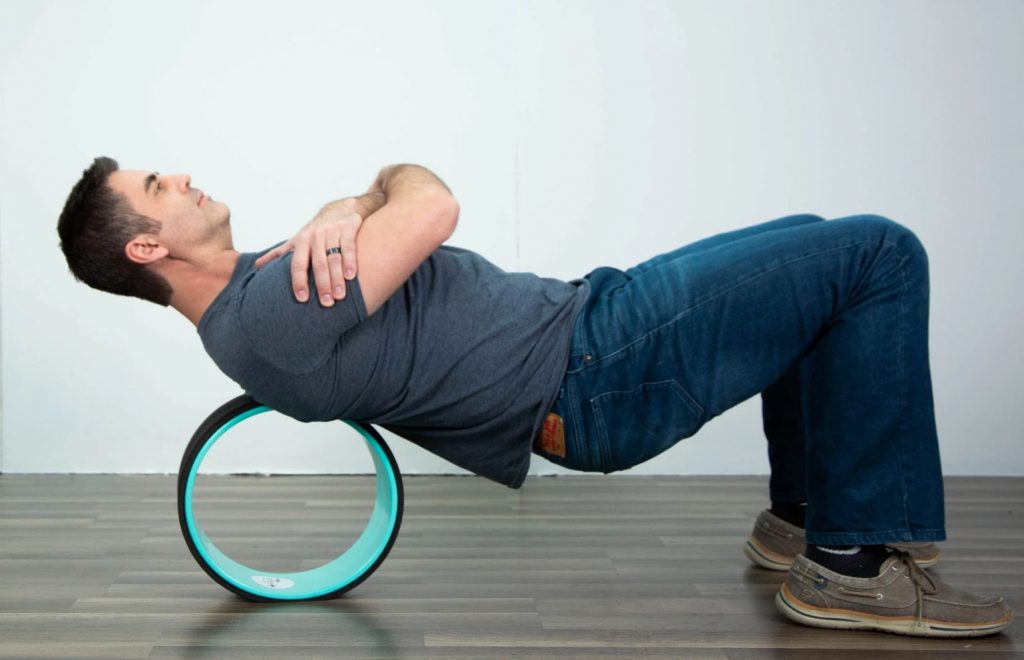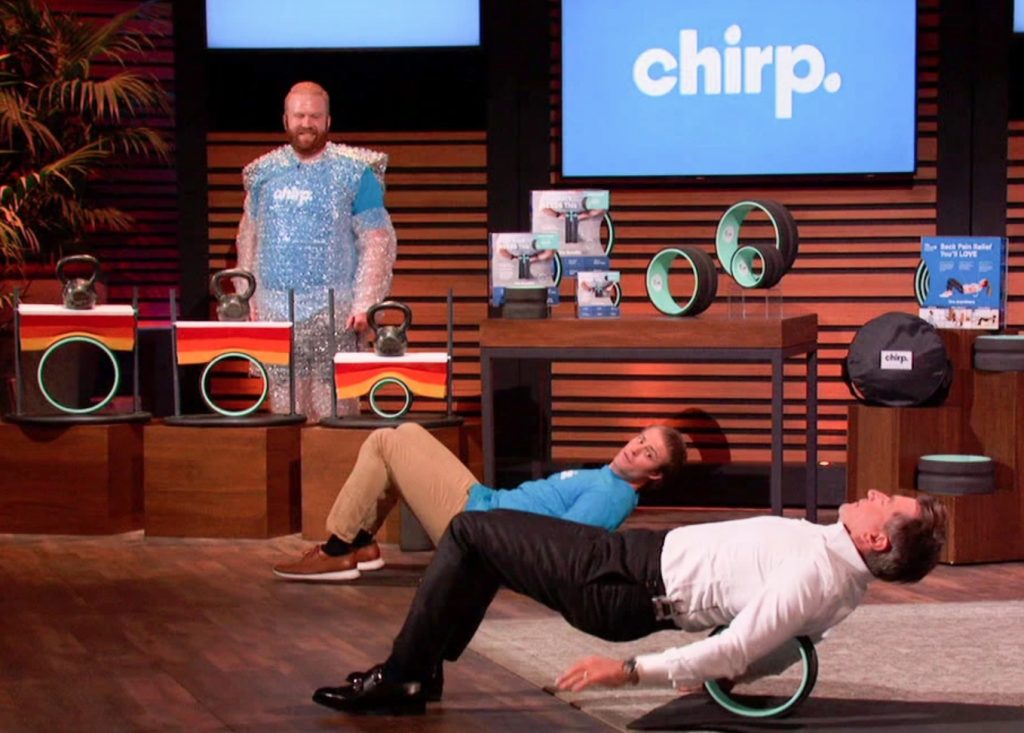Undeniably, the COVID-19 pandemic has negatively affected so many businesses globally but one of the lucky few that flourished is Chirp. With a majority of the population forced to stay home, more people have found themselves looking for back pain solutions at home.
Read on to find out how Chirp became a booming business, why Daymond John questioned the company’s appearance on the show, and which Shark decided to invest in the company.
Chirp Wheel for Back Pain (Shark Tank Highlights)

| What is Chirp Wheel? | A wheel to help relieve back pain |
| Proposed Deal by Owners | $900,000 for 2% equity |
| Owners’ Valuation | $45 Million |
| Shark who Secured Deal | Lori Greiner |
| Shark’s Offer | $900,000 for 2.5% |
| Chirp Net Worth | $36 Million |
What is Chirp?
The Chirp wheel is a wheel that helps users alleviate back pain by assisting in stretching the whole back. It comes in three diameter sizes – gentle, medium, and deep tissue – depending on the area that requires stretching and the intensity of the stretch needed.
The largest wheel with a 12-inch diameter is called Gentle. It gives an overall stretch and is good for addressing upper and lower back pain.
The Medium wheel has a 10-inch diameter and can be used for both overall and targeted stretch.
The 6-inch Deep Tissue wheel is travel-sized and is best used for targeting stiff neck and shoulder muscles. All of the wheels are light-weight, easy to stow away, and can be used without any assistance.
Made of injection-molded plastic, the Chirp wheel can handle up to 500 lbs. of weight. It has a soft EVA foam layer with the Spinal Canal, a ridge in the middle of the wheel that allows for a four-way stretch of the back muscles.
Currently, it is the only wheel available on the market that is FDA-registered as a Class 1 Medical Device. Using the Chirp wheel consistently can supposedly strengthen back muscles and release muscle tension. It is said to even help users sleep better since the muscles relax when users roll out on the Chirp wheel.
Here’s a YouTube video showing how to use the Chirp wheel to reduce back pain.
How did Chirp start?
Chirp founder and CEO, Tate Stock developed the Chirp wheel while he was still a senior in economics at Brigham Young University. He was inspired by his aunt’s yoga wheel and thought about how to improve it.
Stock initially spent $400 on PVC pipes and yoga mats for his prototype. He came up with a more comfortable wheel and put it up for sale on Amazon.com. Within his first two weeks, he sold more than 100 wheels and made $12,000.
With $100,000 savings from his summer job selling pest control products door to door, Stock started producing more wheels. He eventually found a factory in China to manufacture for him.
Unfortunately, the factory stole Stock’s design and sold wheels to other sellers on Amazon. Stock decided to pull out of China and continued manufacturing in Utah where all the wheels have been made since.
Chirp featured on Shark Tank
Tate Stock’s pitch had a rocky start when he declared his company’s valuation. With a $45 million valuation, Shark Daymond John accused Stock of coming to the show purely for promotion.
The tension eased a little when Chirp’s owner explained that his company already made $12 million in sales for 2020 alone and made $4 million in profit at the time of taping the Shark Tank episode.
The company is said to be on track to earn $40 million in sales and $12 million in profit by the end of 2020.
The Chirp founder was hoping that he could reel in a Shark who was willing to invest $900,000 in his company in exchange for 2% equity. He explained that he needed the investment from the Sharks to fund large purchase orders to keep up with the demand.

What were the Sharks’ offers for Chirp?
Despite the tension in the beginning of his pitch when he valued the company at $45 million, Chirp founder and CEO Tate Stock received three offers from the Sharks.
Shark Lori Greiner made the first offer of $900,000 to be paid back by the end of 2021 in exchange for a 2% stake in Chirp.
Shark Kevin O’Leary jumped in, saying, “I like sales, you like sales. I can get you 15% less on customer acquisition. Whatever you’re doing, my team can do it better.”
He offered to invest $9000,000 for a 2.5% stake plus a $3 royalty per unit until he is paid $2.7 million. He added that he was not putting any time pressure on when he gets his investment back.
Shark Daymond John told Stock that he wanted to give an opportunity to businesses who are just starting out or are not doing as well as Chirp was. He added that he was not taking Chirp’s success against Stock but that it did not feel right at the time, so he was out.
On the other hand, Shark Mark Cuban acknowledged that although Stock was good at sales, he felt that there was the COVID element that escalated sales. Cuban said it was not certain that the sales would go straight up onwards, and for that, he opted out of making any offer.
Meanwhile, Shark Robert Herjavec was not deterred by the uncertainty. “Sales do not lie, ever. You’ve hit magic. How long that’s gonna last? I don’t know. But I wanna go along for the ride,” he said.
Herjavec made an offer of $900,000 in exchange for 3% stake in the company, plus a royalty of $1.50 per unit sold until $1.2 million is paid. Interestingly, it was the first time in 12 years that Herjavec made a royalty deal.
Stock asked Herjavec if he would be willing to team up with Greiner. To which Greiner quickly responded, “Why would I want to partner?”
Greiner then changed the conditions of her initial offer. She would give $900,000 in exchange for 2.5% equity, and Stock was to pay her $500,000 by the end of the year, and the remaining $500,000 by the end of 2021.
Stock made a counter offer to Greiner with $900,000k payable in 18% months in exchange for 2% stake in his company.
“2.5% and you have a deal,” replied Greiner.
“What happened to the 2%?” asked Stock.
This exasperated Cuban, who said “Either you want a partner or you don’t, Tate! I mean, seriously! You have no partners.”
Here’s a YouTube video of the Chirp negotiations on Shark Tank, courtesy of ABC.
Did Chirp get a deal on Shark Tank?
After going back and forth on counter offers with Lori Greiner, Chirp’s owner Tate Stock finally accepted Greiner’s final offer.
Greiner would invest $900,000 in Chirp, payable in 18 months in exchange for 2.5% equity in the company.
What happened to Chirp after Shark Tank?
After appearing on the third episode of Shark Tank’s 12th season, Chirp has continued to do well. On the company website, there is a special Shark Tank offer.
Chirp founder and CEO founded his own fulfillment and shipping company, ShipStud, when shipping and fulfillment costs for Chirp were getting to high for his liking. ShipStud also caters to other startups.
Is Chirp still in business today?
Yes, Chirp has continued to provide back ache relief at home. The Chirp wheel plus is available on their website and on Amazon. It currently has a 4.4 star rating from more than 3,000 ratings on Amazon.
How much is Chirp worth now?
Chirp’s founder valued the company at $45 million, justifying it by saying that the company is on track to earn $40 million sales in 2020.
Lori Greiner’s investment of $900,000 for 2.5% equity slightly reduced the worth of the company to $36 million but, admittedly, this is still one of the companies featured on Shark Tank with a hefty valuation that secured a deal from Shark Tank.
Lessons from Chirp on Shark Tank
Shark Tank is a show that is known for helping out startups with funding. Although Chirp may be on the bigger side of businesses that appeared on Shark Tank, Chirp founder and CEO was able to justify why he needed a Shark to partner with.
The increased demand for his products was just too much for him to keep up with the cost of fulfilling purchase orders for manufacturing. It is only logical to bring in a partner for the business since Stock did not have any at all. Lori Greiner will not only provide additional funding but also add her knowledge in effectively marketing simple home products to more consumers.
Stock also showed that even with his small capital of $400, improving an existing product, and making use of his sales skills, he was able to build his company from scratch. He should serve as an inspiration for entrepreneurs who feel like you need to have a huge sum of money for capital to start a business.
Stock also utilized Amazon.com, one of the many online retailing platforms available, to sell Chirp’s first products. Entrepreneurs now are lucky to have such platforms. Stock did not have to reinvent the wheel, he improved it and now thanks to him, hundreds of thousands of happy customers can enjoy being backpain-free without even leaving their homes.

